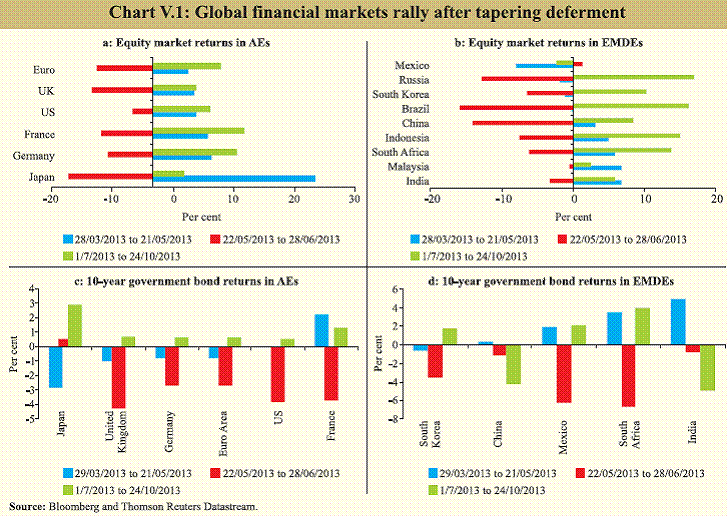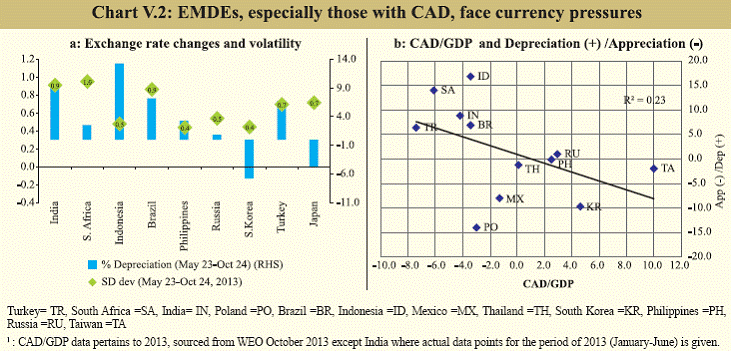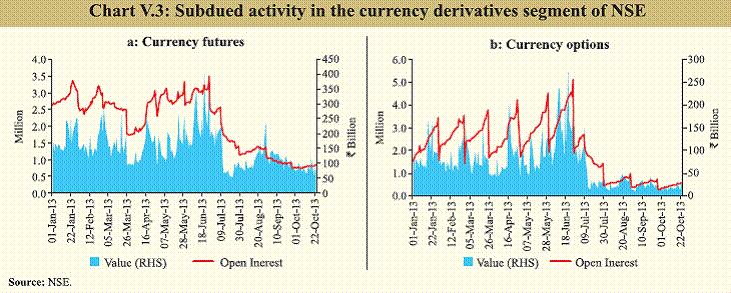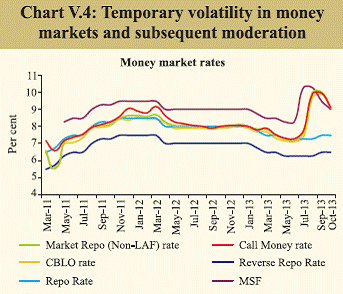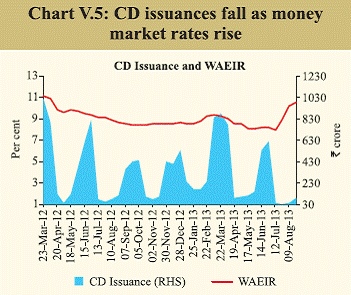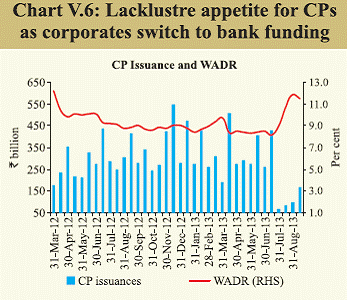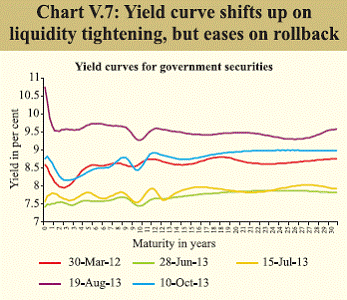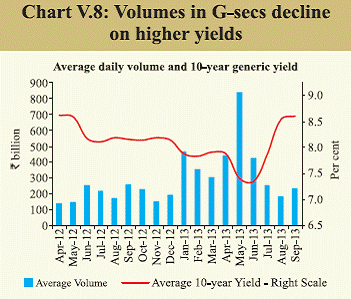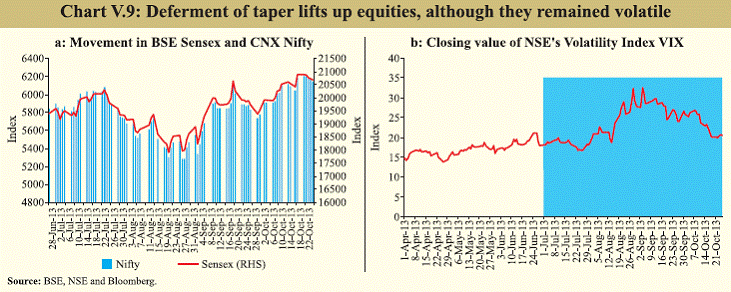V. Financial Markets - ആർബിഐ - Reserve Bank of India
V. Financial Markets
The decision by US Fed in September 2013 to maintain its pace of bond purchases appears to have considerably calmed markets. Since then, EMDE equity markets and currencies have rallied. Pressures in bond markets have also slackened. Tracking these global developments and significant policy actions by the Government and the Reserve Bank, Indian stock markets turned around in September 2013 after the slump in the preceding two months. The Rupee also strengthened in response to improved trade flows and return of equity inflows. While markets have got a temporary breather, near-term uncertainties remain and steps need to be taken to build buffers to manage contingent risks. Fed announcement lowers near-term uncertainties V.1 Although the exact timing of a possible tapering by the Fed remains unclear at present, what is obvious is that market participants have been making adjustments to a new world of potentially less liquidity. In the aftermath of the Fed indication on May 22, equity, bond and currency markets across countries and especially in emerging markets had experienced significant losses. Unsettled geo-political environment in some Middle East countries which raised crude oil prices had further added to the selling pressures. V.2 In the H1 of 2013 till mid-May, equities had experienced significant rally, aided, among others, by accommodative monetary policies by central banks of the advanced economies. US bonds also rallied in April 2013. However, the Fed’s communication about exit from QE led to sharp fall in the prices of these risky assets for both advanced and emerging market and developing economies (EMDEs) (Charts V.1). V.3 In the start of Q3 of 2013, global financial markets witnessed volatility on the back of speculation over the timing of tapering off of QE by the Fed. In general, there was an outflow of capital from EMDEs, especially to the US. This reversal prompted a spike in the Emerging Market Bond Index (EMBI) spread to nearly 375 basis points (bps) by end-August from around 278 bps on the eve of the Fed tapering off statement; EMDE stocks declined and their currencies also depreciated. Country-specific issues such as weaknesses in the current account, subdued export growth and infrastructural bottlenecks aggravated their concerns. V.4 The Fed’s decision on September 18 to continue with the monthly quantum of asset purchase, stating that they will await more evidence of an enduring economic recovery before adjusting their pace, brought significant improvement in market sentiments. Equity markets in advanced economies and EMDE equity markets surged, government bond yields moderated and currencies appreciated against the US dollar. Although the signing of the fiscal deal on October 17 has avoided potential debt default by the US, concerns remain since the deal only funds the US government through January 15, 2014 and raises the debt ceiling through February 7, 2014. Further contentious debate over spending cuts and entitlement programmes seem likely to ensue over the next several months. In October so far (up to October 24, 2013), the equity markets in select EMDEs increased by 5.7 per cent on an average. Pressure on Rupee appears to be abating V.5 Subsequent to the Fed’s ‘announcement effect’, downward pressure on the local currencies along with considerable volatility was discernible across major EMDEs. This permeated both countries with CAD as well as those with current account surpluses. Among the former, the volatility was particularly high in the case of South Africa, India and Brazil. After touching a historical low of 68.36 per dollar on August 28, 2013, the spate of policy initiatives enabled the Rupee to recover (as on October 24, 2013) by almost 10 per cent (Chart V.2). Currency derivatives activity subdued V.6 The impact of the regulatory measures announced by the Reserve Bank and SEBI against the backdrop of heightened exchange rate volatility, were manifest in the derivatives market wherein activity in the currency derivatives declined in Q2 of 2013-14 (Chart V.3). Initial money market upheavals and subsequent moderation V.7 The situation in the money market was comfortable during the first half of July 2013. However, the exceptional measures taken by the Reserve Bank during July and August 2013 impacted the money market. The weighted average call and CBLO rates increased to 9.97 per cent and 9.90 per cent, respectively, in September 2013 (Chart V.4). In continuation of its move towards calibrated withdrawal of the exceptional measures, the Reserve Bank on October 7, 2013 lowered the MSF rate by 50 bps to 9.0 per cent and announced additional liquidity measures in the form of term repos of 7-day and 14-day tenor for the amount equivalent to 0.25 per cent of banking system NDTL through variable rate auctions every Friday beginning October 11, 2013. As a result, the money market rates softened with the average call and CBLO rates standing at 8.92 per cent and 8.97 per cent, respectively on October 25, 2013. Decline in CD issuance V.8 The measures by the Reserve Bank aimed at tightening liquidity appears to have impacted this segment, with the weighted average effective interest rate (WAEIR) of CDs increasing to 11.20 per cent on September 6, 2013 from 8.19 per cent as at end-June 2013 (Chart V.5). The average gross fortnightly issuance of CDs declined to `96 billion during Q2 of 2013-14 (up to September 6, 2013) from `340 billion during Q1 of 2013-14. The outstanding amount of CDs also declined to `3,011 billion as on September 6, 2013 from `3,645 billion at end-June 2013. Appetite for CP lacklustre V.9 With rise in discount rates, the appetite for CP issuance has fallen markedly and corporates are substituting funding through the instrument with alternative financing sources, especially bank credit. The weighted average discount rate (WADR) of CPs increased to 11.53 per cent as on September 15, 2013 from 8.54 per cent at end-June 2013 (Chart V.6). G-secs yields moderate V.10 The ‘announcement effect’ on May 22, 2013 and subsequent measures by the Reserve Bank led to a significant hardening of G-sec yields. Generic yields on 10-year G-secs peaked to 9.27 per cent on August 19, 2013, after which it softened on announcement of OMO purchase auction on August 20, 2013. The yields hardened to 8.83 per cent on September 30, 2013 after a hike in the repo rate in the mid-quarter monetary policy review (Chart V.7). However, the markets rallied and yields softened after the Reserve Bank announced an OMO purchase auction of `100 billion on September 30, and reduced the MSF rate by 50 bps to 9.0 per cent on October 7, 2013. The 10- year generic G-sec yield closed at 8.65 per cent on October 25, 2013. V.11 The average daily trading volume of central government securities remained low (Chart V.8). Despite rising yield environment, cost of borrowing for government falls V.12 The gross market borrowings of the Central Government through dated securities during 2013-14 (up to October 21, 2013) stood at `3,890 billion (net borrowings of `3,143 billion) as compared with `4,090 billion (net borrowings of `3,234 billion) during the corresponding period of the previous year (Table V.1). The weighted average maturity of the dated securities improved to 14.40 years. The benchmark 10-year yield in the primary auctions eased during early 2013-14 touching a low of 7.16 per cent on May 21, 2013 and remained subdued. The yields increased significantly post July 15, 2013 due to liquidity tightness. Despite this, the weighted average cost of borrowing so far has remained much below that in the corresponding period of the previous year. However, the quantum of devolvement till October 24, 2013 increased to `163.76 billion as compared to `18.28 billion in the corresponding period of the previous year. V.13 During 2013-14 (up to October 24, 2013), 24 states raised `970 billion on a gross basis (net amount of `654 billion) as compared with `966 billion (net amount of `862 billion) raised by 25 states in the corresponding period of the previous year. In the corresponding period, the weighted average yield eased to 8.88 per cent up to October 24, 2013 from 8.93 per cent during the corresponding period last year. Equity market responds to measures and taper deferment to register gains V.14 During the financial year 2013-14 (till October 25, 2013), the stock markets have gained 9.8 per cent (Sensex) and 8.1 per cent (Nifty). This movement, however, masks wide gyrations over the period (Chart V.9a). After initial gains, the announcement effect of May 22 put the global stock markets into a tail spin. Between May 22 - August 30, the Sensex and Nifty declined by 7 per cent and 10 per cent, respectively, as FIIs disinvested US$ 13 billion in domestic markets during this period. However, the equity market recovered after the Reserve Bank announced a slew of measures on September 4, 2013. The positive feel-good impact of the Fed’s September 18, 2013 announcements also boosted markets. The momentum continued in October as well with the BSE Sensex and Nifty gaining 11 per cent and 13 per cent, respectively till October 25, 2013 over September 4, 2013. Confidence also returned, with FIIs investing US$ 1.0 billion in equity and debt segments during September- October (upto October 24, 2013). Equity market volatility, measured by NSE’s VIX index heightened during Q2 of 2013-14 (Chart V.9b). Primary capital market remained lacklustre V.15 During H1 of 2013-14, an amount of about `32 billion was raised from the primary equity market through 24 issues. Resource mobilisation via private placements declined sharply. Resources mobilised by mutual funds during H1 of 2013-14 also declined drastically, mainly on account of heavy redemptions recorded in debt-oriented funds, especially during June-July and September 2013. Resources mobilised through ADR/GDR also fell substantially (Table V.2). Turnover in the equity derivatives segment surges V.16 During April-August 2013, the turnover in equity derivative segment increased by 29.0 per cent to `206.7 trillion from `160.3 trillion in the corresponding period last year. Trading volume also increased by 15.3 per cent to 716.3 million contracts during April-August 2013 from 621.1 million contracts in April- August 2012. Crisis of NSEL exposes regulatory gaps prevailing in systemic institutions V.17 Consequent to the directions of the Ministry of Consumer Affairs (MCA) to the National Spot Exchange Ltd (NSEL), NSEL decided to suspend trading of all contracts, including e-contracts as well and settle all one day forward contracts under the supervision of the Forward Market Commission (FMC). V.18 This crisis in NSEL has raised the issue of inter-connectedness of financial institutions. Many brokerage firms are active in multiple segments, including equity, commodity and forex. A loss in one segment of their operations can have a cascading effect on other segments, in turn, propagating contagion effects throughout the market. V.19 The Union Government has taken several policy initiatives to plug regulatory deficiencies. It has transferred the administrative control of FMC to the Ministry of Finance and constituted two committees, one under RBI Deputy Governor, Dr. K. C. Chakrabarty and the other under the Secretary, Department of Economic Affairs, Shri Arvind Mayaram, to look into various aspects relating to this crisis. These committees have since submitted their reports to the Central Government. House price increases abated in Q1 of 2013-14 V.20 The q-o-q growth in the Reserve Bank house price index (Base year:2010-11) at the all-India level was lower at 0.89 per cent in Q1 of 2013-14 (latest available quarter) as compared to 2.46 per cent in the previous quarter. The increase was the highest for Lucknow, followed by Ahmedabad and Kochi (Table V.3). Near-term uncertainties remain a lingering concern V.21 The Fed has decided to wait for more convincing evidence prior to initiating a graduated withdrawal of its bond buying programme. This has provided markets with much-needed breathing space. However, market uncertainties remain associated with how the debt ceiling issues will play out over the next several months and whether the incipient signs of recovery in the euro area sustain. Markets in India also face domestic uncertainties stemming from protracted slowdown, falling corporate earnings and rising leverage, besides risks of political uncertainties associated with the electoral cycle. |












